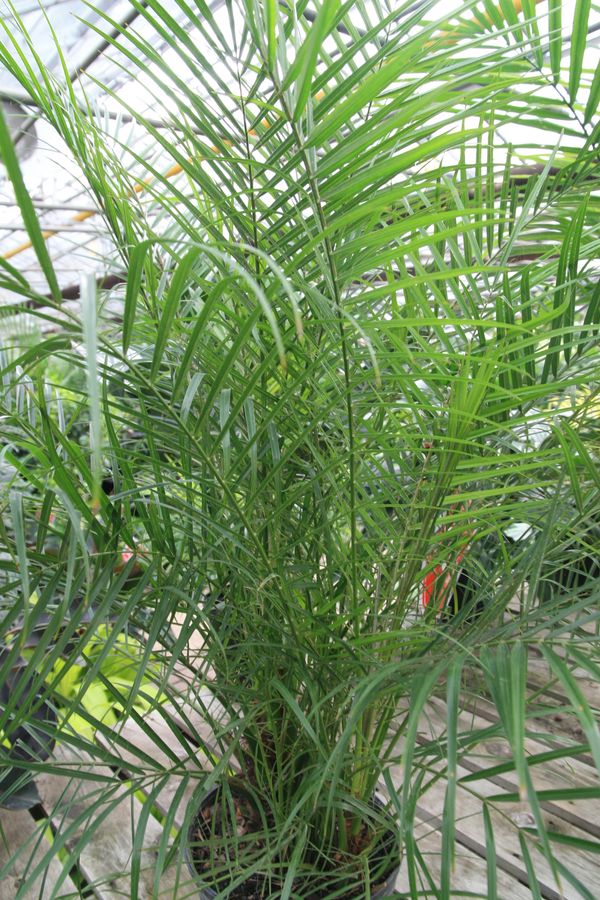Pygmy Date Palm Care Guide
How to grow and care for Pygmy Date Palm (Phoenix roebelenii)
Welcome to the comprehensive care guide for the Phoenix roebelenii, commonly known as the Pygmy Date Palm. This charming and appealing plant is a popular choice for indoor settings due to its manageable size and graceful, feathery fronds. Native to Southeast Asia, the Pygmy Date Palm brings a tropical feel to your indoor space. Let’s explore how to provide the best care for this delightful plant.

Disclosure: This content includes affiliate links, which means we may earn a commission if you click on a link and make a purchase. As an Amazon Associate, we earn from qualifying purchases. This comes at no extra cost to you and helps offset the cost of running Leafwise. Please read our disclaimer for more info.
Table of Contents
Care
Light
Phoenix roebelenii thrives in bright, indirect sunlight but can tolerate partial shade. Avoid direct harsh sunlight, especially during midday, as it can scorch the leaves. Position your palm near an east or west-facing window for optimal growth.
Temperature & Humidity
Maintain a temperature range of 65-85°F (18-29°C), ensuring it does not drop below 50°F (10°C). This palm thrives in moderate to high humidity. If the indoor air is dry, use a humidifier, a pebble tray, or mist the leaves occasionally to maintain moisture levels.
Watering
Water your Pygmy Date Palm thoroughly, allowing the top inch of soil to dry out between waterings. It prefers consistently moist soil but does not tolerate standing water, which can lead to root rot. Reduce watering in the fall and winter when growth slows.
Soil
Use a well-draining potting mix, such as a palm or cactus blend. A mix containing peat, perlite, and sand will help maintain proper drainage and aeration, preventing root rot.
Fertilization
Feed your plant with a balanced liquid fertilizer, diluted to half strength, once a month during the growing season (spring and summer). Avoid fertilizing in fall and winter when the plant’s growth slows.
Maintenance
Pruning
Regularly remove any dead or yellowing fronds to keep your palm looking its best. Use clean, sharp scissors or pruning shears to prevent disease transmission.
Cleaning
Dust can accumulate on the leaves, reducing their ability to absorb light. Wipe the leaves gently with a damp cloth or rinse them under lukewarm water occasionally. Avoid using leaf shine products, as they can clog the plant’s pores and impede respiration.
Repotting
Repot the Pygmy Date Palm every 2-3 years in a slightly larger pot to accommodate its root system. Choose a pot with drainage holes to prevent waterlogged soil and refresh the potting mix.
Propagation
Phoenix roebelenii is typically propagated through seeds, as they rarely produce offsets indoors. To propagate by seed:
- Collect fresh seeds from a mature plant.
- Soak the seeds in warm water for 24 hours to enhance germination.
- Plant the seeds in a well-draining soil mix and keep them in a warm, humid environment.
- Maintain consistent moisture, but avoid overwatering.
- Germination may take several weeks to months, so patience is required.
Common Issues
Pests
Common pests: Spider mites, mealybugs, and scale insects.
- Symptoms: Yellowing leaves, sticky residue, or webbing.
- Solution: Treat with insecticidal soap or neem oil, ensuring thorough coverage of affected areas. Increase humidity slightly to deter spider mites.
Root Rot
- Symptoms: Mushy roots, wilting leaves, or a foul smell.
- Solution: Improve drainage, reduce watering frequency, and trim any affected roots before repotting in fresh soil. Avoid letting water sit in the plant’s saucer.
Yellowing Leaves
- Cause: Overwatering, nutrient deficiency, or lack of light.
- Solution: Adjust your watering schedule, provide adequate indirect light, and fertilize during the growing season if needed. Trim yellowed leaves to maintain the plant’s appearance.
By following these care guidelines, your Pygmy Date Palm (Phoenix roebelenii) will thrive, adding a tropical and elegant touch to your indoor or outdoor space.
